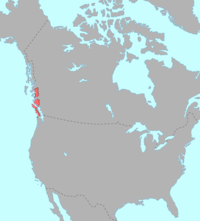Wakash languages
The Wakash languages or Wakashan languages ( English : wakashan languages ) are an indigenous North American language family , the six languages spoken in Canada in British Columbia and on Vancouver Island and a sleeping language (Makah), which is in the north of the Olympic Peninsula in Washington , USA was spoken.
classification
-
Wakashan
-
North Wakashan
- Haisla (Xenaksialak'ala / Xa'islak'ala / Kitamat) (263 speakers FPCC report 2014 , 25 speakers Ethnologue 2009 )
- Kwak'wala (Kwakiutl) (language of the Kwakwaka'wakw ; 664 speakers FPCC report 2014 , 270 according to Ethnologue 2009 )
- Heiltsuk-Oowekyala
- Heiltsuk (Bella-Bella, Hailhzaqvla) (105 speakers FPCC report 2014 , 300 speakers Ethnologue 2009 )
- Oowekyala ('Uik'ala) (11 speakers FPCC report 2014 )
-
South Wakashan
- Makah (qʷi qʷi diččaq) (language of the Makah ; no native speakers, 12 L2 speakers UNESCO World Atlas of Endangered Languages ).
- Nitinaht (DiitiidɁaatx / Ditidaht) (language of Ditidaht ; 13 speakers FPCC report 2014 , 30 speakers Ethnologue 2009 )
- Nuu-chah-nulth (Nuučaan'uƚ) (language of the Nuu-chah-nulth ; 231 speakers FPCC report 2014 , 170 speakers Ethnologue 2009 ).
-
North Wakashan
The linguistic gap between the north and south groups is relatively large, while the languages within these groups are closely related.
External relationships
Chimakum and Mosan
An older proposal genetically links the Wakashan languages with the almost extinct Chimakum languages . The languages of both groups are typologically similar and have some lexical similarities, which Campbell 1997 traced back to area contact phenomena. In addition, Edward Sapir and Morris Swadesh suggested that both families and the Salish languages belong to the Mosan , although Swadesh later changed his mind and considered the Wakash languages to be related to Eskimo Aleut, although he did not publish anything about this.
Eskimo Aleut
According to this theory, initiated by Morris Swadesh and expanded by Jan Henrik Holst , the Wakashan languages are related to the Eskimo-Aleut languages . Holst (2005) justifies this with a list of 62 word equations , the derivation of some sound laws and grammatical evidence. This relationship crosses the line drawn by Joseph Greenberg between the Eskimo-Aleut and the Amerind languages (see there).
Common grammatical properties
Phonology
Wakash languages are characterized by a large phoneme inventory . A series of ejectives and a series of labialized consonants are characteristic. There are also a large number of affrictions .
morphology
Wakash languages, like most North American languages, are polysynthetic . The Wakash languages have a large number of lexical affixes and have an evidential system . They show a distinction between nouns and verbs that is only very weakly represented by morphosyntactic properties (cf. part of speech ).
literature
- Lyle Campbell : American Indian Languages. The historical linguistics of Native America. Oxford University Press, Oxford 1997, ISBN 0-19-509427-1 , ( Oxford studies in anthropological linguistics 4).
- Jan Henrik Holst : Introduction to the Eskimo-Aleut languages. Buske Verlag, Hamburg 2005, ISBN 3-87548-386-3 .
- M. Paul Lewis: Ethnologue. Languages of the World. 16th edition. Summer Institute of Linguistics, Dallas Tx 2009, ISBN 978-1-55671-216-6 .
- Marianne Mithun: The Languages of Native North America. Cambridge University Press, Cambridge 1999, ISBN 0-521-23228-7 , ( Cambridge language surveys ).
Web links
- The Wakashan Linguistics Page
- Source there on external relationships
- Website First Voices - Kwakwala
- Website First Voices - Haisla
- Website First Voices - Nuu-chah-nulth
Individual evidence
- ^ A b c d e f First People's Cultural Council: Report on the Status of BC First Nations Languages 2014. In: www.fpcc.ca. Accessed December 6, 2017 .
- ^ UNESCO: UNESCO Atlas of the World's Languages in Danger. In: www.unesco.org. Accessed December 6, 2017 .

